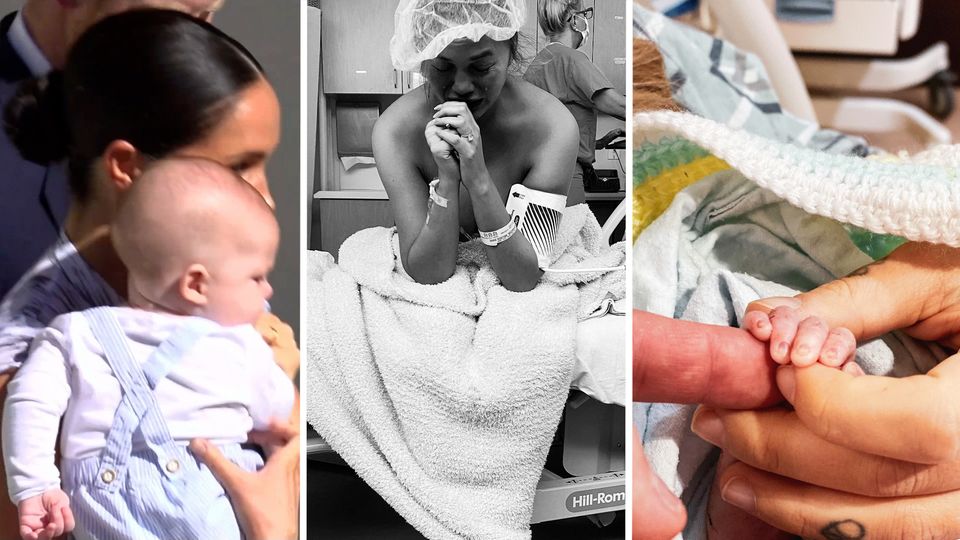The journalist Eva Lindner experienced a miscarriage and collected her and other sufferers’ stories in a book. Dem star She explains why the 3-month rule can be dangerous and what Prince Harry did wrong when it came to miscarriage.
When Eva Lindner experienced her miscarriage, she was 16 weeks pregnant with her second child. At night, the journalist suddenly goes into labor, her amniotic sac bursts, then everything happens very quickly: with tears, pain and blood, she gives birth to her baby dead in the bathroom. Her husband faints briefly and their three-year-old daughter is sleeping in the next room. When Lindner later lies on the operating table in the hospital, crying and in shock, the anesthesiologist jokes with the staff. All around her: routine. Inside her: despair, sadness, emptiness.
“For me it is a catastrophe,” writes Lindner in her book “Mother without a child: The taboo of miscarriage and what needs to change.” In it she describes this catastrophe right from the start with impressive images that are almost unbearable while reading. The author tells him that she sometimes gets that mirrored star. “There are people who can’t continue reading the book. I think that’s a shame. It’s important to acknowledge pain and sadness. People should see this pain that women suffer every day.”
Why the “12 week rule” is misogynistic

“Mother without a child: About the taboo miscarriage and what needs to change” by Eva Lindner was published by Tropen-Verlag. 271 pages, hardcover, 22.00 euros.
© PR
That’s why, in addition to her experience, she also wrote down those of ten other women. And she consults studies and speaks to experts. “Mother without a Child” is a book that touches and at the same time sheds light on the different dimensions that a miscarriage can have: from the shockingly poor level of research in medicine to the relationship and psychological problems that can follow. It becomes clear what has long been proven with figures: the stories in her book are not the exception, but everyday life.
Almost every third pregnancy is affected, and there are 23 million miscarriages every year worldwide. 44 lose every minute women around the world their pregnancy. “Even now, at this very minute,” writes Lindner. One in two of the women affected suffers psychological consequences. Nevertheless, the families are usually left alone with their pain. Among other things, because miscarriages are still taboo.
“The ‘twelve week rule’ is also to blame for this: There is this social norm that it is better to hide a pregnancy in the first three months, because 80 percent of miscarriages occur there,” explains Lindner. “Women are expected to only talk positively about their pregnancy. But we don’t tell each other how many complications, risks and also loss and grief come with pregnancies.” But it is misogynistic that women have to suffer in silence and secretly. With “Mother without a Child” Lindner wants to fight against the taboo, educate and show affected women: You are not alone.
Prince Harry has linked the miscarriage to the theme of guilt
“It’s really important to educate people about the frequency of miscarriages. This helps so that you don’t feel lonely or defective,” says the 40-year-old. Before her own experience, she had hardly thought about the topic and thought she didn’t know anyone who had experienced it. “Today I know that that’s not true. Often this own experience opens the door for others to dare to talk about it.” In fact, more and more celebrities are speaking publicly about miscarriages, from Chrissy Teigen to Robert Geis to Beyoncé. The best-known example is perhaps Duchess Meghan, who very emotionally described her miscarriage in the “New York Times” in the summer of 2020. Such stories are important, says Lindner, but in the Meghan case she sees Prince Harry’s later statements as problematic.
“He blamed the DailyMail newspaper, with which his wife was in a legal dispute, for her miscarriage. This is a common story that says: Miscarriages happen when someone is under a lot of stress. Stress only occurs in exceptional cases the reason for a miscarriage. Most often when it is very traumatic, such as a rape or an escape experience. Many people think that ordinary work stress or relationship stress can lead to miscarriages, but that is not the case,” says Lindner. After miscarriages, most women tormented themselves with feelings of guilt and doubted themselves and their bodies. But the most important message to those affected is: You are not to blame. The reasons for miscarriages are chromosomal abnormalities in 60 to 85 percent of cases.

Eva Lindner is the author of “Mother without a child: The taboo of miscarriage and what needs to change”
© Anna McKay
“Our doctors have to tell us that!”
“This number is important to know because it then becomes clear that the woman cannot do anything about it. No matter how healthy she eats, does so much exercise and relaxes,” emphasizes Lindner. And there is another number that many people don’t know, but which gives hope: “75 percent of women have a healthy child after a miscarriage. And if they are under 30, the figure is even 85 percent. I think that’s what we have to do Doctors say so that the situation doesn’t seem so hopeless,” says Lindner. “But most women are dismissed from the practice with: ‘Just try again!’ And that seems arbitrary and unempathetic at the moment.”
In the book, Lindner examines the question of what could make the situation better for those affected and also finds political answers. For example, the ban on imports of the drug Cytotec, which is essential for medical therapy after a miscarriage, is just one example of the structural neglect of women in medicine. In addition, an initiative is currently fighting with a petition for maternity protection to also apply to births before the 24th week of pregnancy. However, Lindner sees the biggest grievance as the fact that there is no systematic training for medical staff. The psychological consequences of a miscarriage have been well researched. “More than 50 percent of women suffer from severe depression one month after the miscarriage, and the risk of suicide increases fourfold. Many women still show symptoms months after the loss that we know from war veterans or severely traumatized people. It is important “To know how to take good care of the women and not leave them alone. You would have to accompany them closely, ask them again and again afterwards and offer help.”
Eva Lindner herself found help in a yoga group for mothers of star children, as the babies are often called. And she sought advice from a therapist. Writing to “Mother without a Child” also helped her to process what she had experienced. She and her husband have now had another healthy daughter. Today, when she’s asked in a familiar setting how many children she has, she answers: “I’m the mother of three children. That’s the feeling I have. And I think a lot of women feel that way.”


